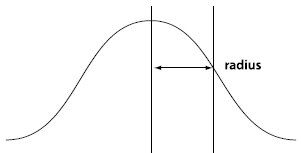
recently felt that some netizens' research on Gaussian blur filter is now summarized as follows. Gaussian blur is a kind of digital image template processing method. Its template is calculated based on a two-dimensional normal distribution (Gaussian distribution) function.
The normal distribution was first obtained by A. Demoivre in finding the asymptotic formula of the binomial distribution. C.F. Gauss derived it from another angle when studying measurement error. P.S. Laplace and Gauss studied its properties. Hence the name Gaussian blur.
Function definition of one-dimensional normal distribution:
Distribution of type random variables, the first parameter μ is the mean value of the random variable that follows the normal distribution , the second parameter σ2 is the variance of this random variable, so the normal distribution is recorded as N(μ, σ2). The probability rule of a random variable that follows a normal distribution is that the probability of taking a value near μ is high, and the probability of taking a value that is farther away from μ is smaller; the smaller σ, the more concentrated the distribution is near μ, and the larger σ, the smaller the distribution. dispersion. The characteristics of the density function of the normal distribution are: symmetric about μ, reaching a maximum value at μ, taking a value of 0 at positive (negative) infinity, and having an inflection point at μ±σ. Its shape is high in the middle and low on both sides, and the image is a bell-shaped curve above the x-axis. When μ = 0, σ2 = 1, it is called the standard normal distribution, recorded as N (0, 1). 

Based on this formula, we can calculate the Gaussian templates under different radii. In fact, the templates are infinite, but they will approach 0 far away from the center. For example, we calculate r A normalized Gaussian template when =0.7:
高斯模板(guass radius=0.700000)
在网络上众所周知流传的高斯3*3模板实际上是对高斯曲面的一个整数除法形式的近似:
1 2 1
2 4 2 /16
1 2 1
Actual verification, we found that this 3*3 template is actually an approximation of the Gaussian radius when it is about 0.849. When r=0.849, its 3*3 normalized template is (in MATLAB, enter h=fspecial('gaussian', 3, 0.849);You can get this template): 0.062467 0.125000 0.062467
0.125000 0.250131 0.125000 0.062467 0.125000 0.06246 7## Then we can use imfilter in Matlab to perform Gaussian blur processing on the image:
img = imread('c:\demo.bmp'); h = fspecial('gaussian', 3, 0.849);
subplot(121), imshow(img); title('Original image')
subplot(122), imshow(img2); title('After Gaussian blur')
# The effect is as follows: We can use it in Matlab as follows Statement to draw Gaussian surface:
Matlab code for drawing Gaussian surface

http:/ /m.sbmmt.com/
-->%math.h>include
stdio.h>
define## N 3 3 / * Template size: (2N+1) * (2N+1) */
void main(){
double a[2*N+1][2*N+1]; /* Gaussian template*/ /* Gaussian radius: [0.1, 250] */
double A=1/
(2*##M_PI*r*r); int i,j; for(i=-
1*
N;i N;i++) for(j=-1 *N;j
N;j++)a[i+N][j+N]=A *exp((-1)*(i*i+j*j)/ (2*r*r));
}
case 'gaussian' % Gaussian filter
siz = (p2-1)/2; %注:p2即模板边长,默认值为33
std = p3; %注:p3即高斯半径,默认为为0.5
[x,y] = meshgrid(-siz(2):siz(2),-siz(1):siz(1));
arg = -(x.*x + y.*y)/(2*std*std);
h = exp(arg);
h(h<eps*max(h(:))) = 0;
sumh = sum(h(:)); %注:模板归一化
if sumh ~= 0,
h = h/sumh;
end;



